

Author, MaryAnn Gerst tackles the Tour du Mont Blanc.
![]()
Over the past two years, says author, MaryAnn Gerst, I have hiked to the top of Mt Kilimanjaro in Tanzania and walked the 500 mile/750 kilometer Camino de Santiago pilgrimage across northern Spain. At three score years and ten, I pondered what my next adventure might be, and decided, along with two friends, Karen Kemeys and Natasha Kolchevsha, to trek the Tour du Mont Blanc (TMB) in the western Alps of Italy, France and Switzerland.
We knew each other through a hiking group in my home state of New Mexico where we discovered we hiked well together, being around the same age and ability. Karen did most of our planning saying “Why pay $4,000 each for a guided tour? We can do this on our own!” So with a map, guidebook and the Internet, we planned our entire tour, paying only for lodging and taxi service for moving our luggage. We made reservations in refugios, small mountain huts, along our trekking route.
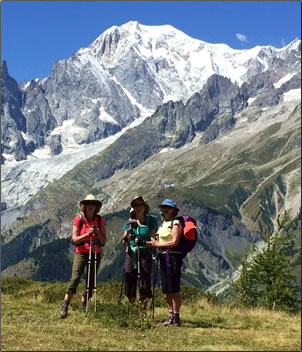
(L to R) Hiking companions, MaryAnn Gerst, Karen Kemeys, and Natasha Kolchevska.
To prepare for our hiking endeavor, we trained for six months in the high mountains of New Mexico, doing three 6-12 mile hikes a week, going up 2,500 to 3,500 feet in elevation on each hike, carrying 12 pound packs.
In July we flew to Geneva, Switzerland and taxied across the Swiss/French border to start our hike in the small village of Les Houches. We kept pinching ourselves saying, “We really ARE doing this!”
Despite our training, the steep, rocky, up-and-down terrain on Mont Blanc required more endurance and stamina than any of my past treks. It was tough going down several thousand feet knowing you would have to regain that same elevation later in the day and then do the same thing day after day. Many times Karen joked, “Where’s the bridge connecting this peak to that one?”
 Hiking in the Italian Alps.
Hiking in the Italian Alps.
There are no trail signs giving you mileage to your daily destination, just number of hours to get there. After the first day Natasha said “I think we should add a third more time to whatever the signs indicate!” We agreed whole heartedly as our planned 4-6 hour days turned into 6-10 hour days! We rationalized this, as most of the hikers were several decades younger than us. But we did get stronger as our days progressed. Our most challenging day was doing 7,500 feet of up and down.
We were in awe of the breathtaking scenery before us, each day viewing ever-changing panoramas. Every time we got to the top of a pass (called a Col) a more stunning view of the Alps greeted us. Every time we went over a Col, my cell phone chirped and I enthusiastically reported to our trio, “I just got a text message welcoming us to Italy (or France or Switzerland).” These messages became our official welcoming committee.
 Trail signs show the number of hours to each destination, not distance.
Trail signs show the number of hours to each destination, not distance.
![]()
The Tour du Mont Blanc is a walking trail in the French, Italian and Swiss Alps making a 180km (112 mile) circuit of Mont Blanc massif, starting and finishing in Les Houches near Chamonix, France. Elevation is 15,780 feet making it the highest peak in the Alps. Massif (“massive” in French) is used to refer to a large mountain mass or compact group of connected mountains forming an independent portion of a range. This massif hosts dozens of glaciers and hundreds of summits and is surrounded by seven major valleys. Trekkers take roughly 10 to 12 days to complete the circuit. According to Wikipedia, an estimated 10,000 hikers did so in 2009.
Our trekking days were spent circling the Mont Blanc Massif, going through lush, flowering meadows, skirting cows and sheep on the hillsides, their bells tinkling to the rhythm of our boot steps on the trail. The sprawling glaciers, majestic rock spires, thundering waterfalls and clear mountain streams and lakes added to the picture perfect landscape. My finger got bruised taking so many pictures!
One day as we were hiking in France and somewhat lost, we started following a hiker as he seemed quite familiar with the trail. Suddenly he veered off the trail onto a rutted path and in panicked unison we all yelled, “Where are you going?” He turned around and said “I’m going home!” Sensing our dilemma, he invited us to accompany him home to meet his wife. We ended up spending a couple of hours with a delightful couple in their newly converted old barn to country home, getting excellent directions to continue our journey.
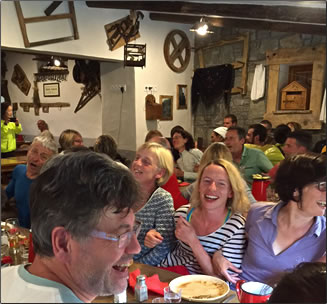 A refugio dinner is shared with a happy bunch of Germans trekkers.
A refugio dinner is shared with a happy bunch of Germans trekkers.
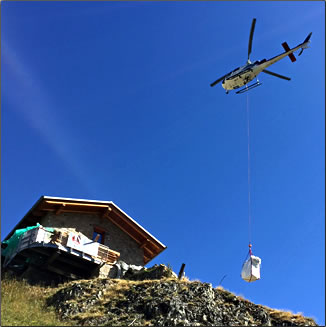
A helicopter regularly drops off food at one of the high mountain refugios.
We had to carry everything we needed in our backpacks, which we packed with extreme care, weighing every ounce that was going with us. I even broke my toothbrush in half to lessen my weight! By the time we added water and food, our packs weighed around 17 pounds. Our treat was having some clean clothes waiting for us every 2-3 days when we stayed in villages at lower elevations where there were roads. We hired a local taxi to transfer one small duffle bag each from one village to another.
But most of the time we stayed in four to eight person dorms in the mountain huts high in the Alps. The huts provided half board (breakfast and dinner), receiving their supplies via helicopter drops every couple of days. Dorm living became quite interesting, as it wasn’t unusual to see a man in his underwear climbing into the top bunk above you. All you were thinking was “I hoping he doesn’t snore!” Then you’d see him again at breakfast, on the trail and at the next Refugio. He was like an old friend after a few days!
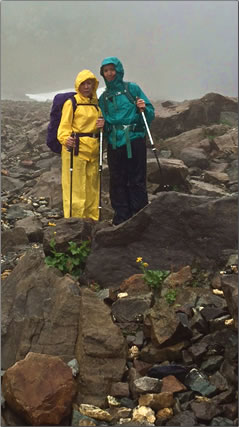 The intrepid trio experienced a four-hour rain storm while searching for their refugio.
The intrepid trio experienced a four-hour rain storm while searching for their refugio.
We did have a few hair rising experiences while hiking. One afternoon a heavy rainstorm moved in and rained on us for over four hours. Unfortunately, my backpack cover didn’t suffice and everything in my pack was soaking wet. A heavy mist and fog settled in about a mile from our shelter and we were terrified that we would never find it before hypothermia set in. Karen’s arms were getting numb from the cold, as we crossed a raging waterfall that was expanded by the rainstorm.
She got to the waterfall first and said, “If I hadn’t seen a hiker cross the waterfall at this spot, I’d never cross it!” We held our breath and gripped our poles; one slip and down we would go! We finally made it to our Refugio along with about 30 other hikers. Everyone was wet, cold and miserable, but sheltered! There were wet clothes hanging from every rafter in hopes of drying out by the next morning. A shepherd’s dinner of warm soup, bread and wine dispelled everyone’s misery. Finally, the comfort of a lower bunk in the dorm room – ah, Heaven!
The next morning we woke to bright sunshine and a gorgeous view of snowcapped peaks stretching endlessly before us. We pinned our wet clothing to our packs and trudged on! We also had one afternoon of ladders. The shear rocks were too steep for a trail so ladders were hinged to the rock walls at various points. Climbing up the ladders with a backpack on was daunting to say the least! It was either climb the ladders or take a lengthy detour to reach our destination. I was first and said “Let’s collapse our poles, stash them in our packs, and start climbing. Don’t look down!” There was a united “Whew” at the top.
Our last day was the best for scenery. We were high in elevation, spending the night at Refuge du Lac Blanc overlooking a beautiful lake. The day was sunny and warm and the entire long range of the Alps, referred to as the terrace or balcony, escorted us back to Les Houches, where we completed our tour. We took the last 2,000 feet down in a cable car, telling ourselves WE DESERVE IT!

Sheer rock faces along the route sometimes require scaling ladders.
![]()
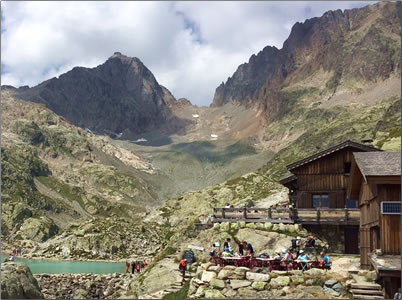 “The Tour du Mont Blanc is not only one of Europe’s classic hikes, but one of the best in the world!” Book reservations well in advance, as refugios only accommodate a limited number of hikers each night.
“The Tour du Mont Blanc is not only one of Europe’s classic hikes, but one of the best in the world!” Book reservations well in advance, as refugios only accommodate a limited number of hikers each night.
Here is a good site for planning your own trip; it also has an excellent map of the oval-shaped route through three countries. There are also companies that plan and book self-guided tours of this route with private rooms or as small-group guided treks. There are many luggage transfer services to use. We used taxibesson@hotmail.com. Definitely take out adequate travel insurance and evacuation insurance.
Packing Tips:
Bring a rain cover for your backpack and two-piece rain gear to keep dry in a deluge. Energy bars and a liter of water are mandatory (pick up extra water as you pass refugios), also any medicines, toiletries, waterproof gloves and a down coat … not surprisingly, it can get cold, especially if it rains or the wind blows. A personal emergency kit consisting of a whistle, reflective mirror, ace bandage, moleskin and head lamp is essential. Silk rules in refugios … wear it as underwear for warmth and to sleep in, and bring a silk sheet set including pillow case. Most refugios offer only a mattress, blanket and pillow.
In our Travel Article Library, you will also find more inspiring stories by MaryAnn Gerst: Colorado’s Pike’s Peak or Bust, Trekking Africa’s Highest Peak Mt Kilimanjaro and New Zealand’s Milford Track.
Photo caption: Refugio Lac Blanc high in the Swiss Alps.
Based in New Mexico, MaryAnn Gerst is a retired Public Relations professional. During her 30-year career in the utility industry, she wrote numerous customer, energy-savings programs and employee training manuals. MaryAnn is a member of the Albuquerque MeetUp Hiking Group in NM and enjoys hiking several times each month with her hiking companions. For her next challenge, she is looking at hiking in Patagonia. Email: gerstmaryann@gmail.com.
